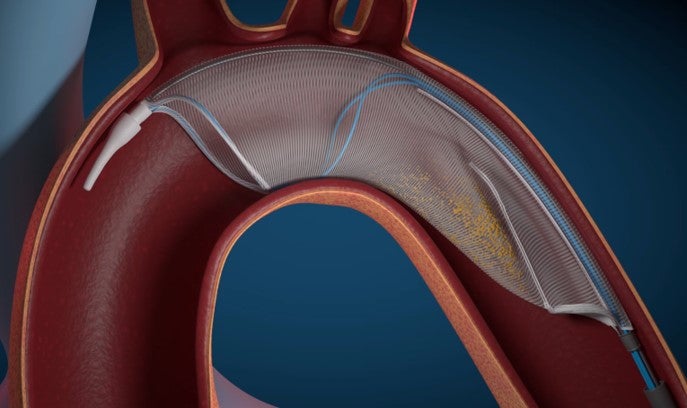
Based in Colleretto Giacosa, Italy, AorticLab’s innovative embolic protection device ‘Flower’ uses exclusive ‘Catch & Flow’ technology which combines cutting-edge design with an ultra-fine mesh. Folded inside the catheter tube used by a cardiologist during Transcatheter Aortic Valve Implant (TAVI) heart procedures, the device is positioned inside the aortic arch, like a flower, to reveal a close fitting exceptionally fine mesh that catches and holds tiny pieces of debris dislodged during the valve implant without making any impairment to the normal fluid-dynamic conditions.
Left to enter the bloodstream, these minute pieces of debris could travel to the brain and block blood vessels or arteries, resulting in a stroke for the patient. Flower fits perfectly within the aortic wall minimising the risk of cerebral damage by covering all three main branches of the aortic arch and the systemic circulation. Once the procedure is complete, the filter then folds up again and is withdrawn, taking the debris away. During the procedure, correct normal blood flow is maintained and the inner surface of the supra-valvular aortic arch is protected.
According to AorticLab, 190,000 patients worldwide underwent TAVI procedures in 2020 and, with an ageing population, it predicts that by 2027 there could be 390,000 cases. The TAVI procedure carries an inherent risk of stroke and of these, 50% are disabling. This new device is designed to reduce incidences of stroke by removing more debris from the patient during TAVI.
Partnering with Sefar
The crucial component in Flower is the ultra-fine mesh, designed and manufactured by medical fabric specialist, Sefar. AorticLab CEO Franco Osta had previously collaborated with Sefar on projects during his time at big multinationals.
“The design of the mesh has been developed together with AorticLab in line with their special requests,” Sefar’s corporate market manager medical, Marcel Rutz, explains. “They requested several properties for the mesh and Sefar used the production capabilities that we have in-house and our engineering team to develop this with AorticLab.”
Sefar, which already produces high precision monofilament fabrics for implants such as valves and stents, was interested in the project from the start, comments Osta. “We recognised a very good relationship with Sefar, even if we were just a start-up. Sefar dedicated attention to our device even though the size and the characteristic of Sefar and AorticLab are completely different. The expectation is for AorticLab to grow quickly, and the quality of the device is crucial for this objective.”
The new mesh catches more debris than any other filter on the market, says Osta. “Using this device, we can capture more debris for two different reasons. One, is the characteristic of the filter fabric. The mesh is just 60 microns, whereas other devices available in the market are 125 microns. Second, is the very normative design of our device, which covers all the cerebral vessels, even the peripheral circulation.
“We are presenting a strong improvement for the benefit of the patient represented by the quality of the filtering fabric and the design of the device. We can capture and protect the cerebral and peripheral districts, while other devices are just protecting, partially, the cerebral region, and not protecting the peripheral region. We have a mesh that covers twice the area of other devices.”
Successful clinical trials in Europe
The Flower has now been used on over 30 patients during clinical trials in Europe. Osta says that the trials have been very successful, with positive feedback from medical professionals. “They are really impressed with the characteristics of our device, including the characteristic of the fabric of the filter, because of its ability for a perfect adhesion to the aortic wall. It means the device is user friendly for the doctor, one of the requirements requested.”
Doctors have reported that the device is quicker to position too, another particularly important benefit. “Our positioning time is less than three minutes, and the target is to achieve position in two minutes and retrieve in two minutes,” says Osta. “This is an important benefit for the hospital. Other devices require more than 15 minutes for the position and return.”
Analysis of the removed filters show that debris is being successfully collected that would have been missed by other devices explains Osta. “We are collecting very good results in terms of material captured by our device and by the filter. During analysis, we are finding an average of more than 200 pieces of different sizes. 30% of them are pieces between 60 and 150 microns; material that other devices filters are not able to capture because they are larger.
“We are also capturing around 7% of material which has a diameter larger than one millimetre. Material of one millimetre would represent a very high stroke risk.”
Moving forward
Due to its successful trials in Europe, the Flower device is now going on to a large clinical trial in the US, involving at least ten US medical centres.
There are still many challenges ahead, but Osta says he is confident that once the device gains approval, expansion will come quickly. Now, he explains, the device is only being made in small quantities, but upon approval, the device will go into full production and initial costs will reduce, making the device market ready. “There are distributors in Europe already strongly interested, because they consider our device a great market opportunity,” he notes.
Sefar’s Jérémie Weber, regional market manager medical, comments on the relationship between the medical fabric manufacturer and the start-up. “This partnership with Aortic is really interesting. We have supported this project through our team of engineers, our project management, and our specialists since the very beginning, from the idea to the first prototypes and to the finalised filter component. At Sefar, we support AorticLab the same as we would a large company.”
For AorticLab, the quality of the mesh that Sefar provides is critical. “It makes all the difference,” says Osta.
To find out more, download the whitepaper below.


